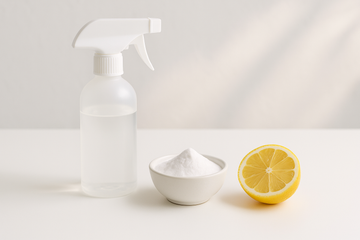How to Remove Soap Scum Naturally (It's Easier Than You Think)
by Kay Baker on Oct 09, 2025
How to Remove Soap Scum Naturally (It’s Easier Than You Think)
Written by: Kay Baker, MS, OTR/L — CEO & Co-Founder • Reviewed by: Matthew Keasey, Ph.D. — Chief Science Officer • Last reviewed: October 9, 2025
Transparency note: Educational guidance with sources so you can check the science. Not medical or legal advice. 24-hour correction pledge: if you spot an error, we’ll review and update within 24 hours.
That cloudy, chalky film clinging to your shower doors, tiles, and bathtub is one of the most persistent bathroom headaches. Many people assume you need harsh, chlorine-bleach cleaners — you don’t. With a little chemistry and the right natural ingredients, you can restore clarity and shine safely.
This is your battle plan for the bathroom. For a broader overview of green cleaning, see our Ultimate Guide to Natural Cleaning Products.
What exactly is soap scum?
Soap scum forms when fatty acid salts in soap react with hard-water minerals (calcium and magnesium) to make insoluble deposits that cling to surfaces. Body soils can add to the buildup. Mild acids dissolve these mineral bonds — that’s why vinegar or citric acid work well on glass, ceramic tile, and fiberglass. Source: American Chemical Society (ACS).
Method 1: Everyday deep clean (50/50 vinegar & water)
Best for: Glass, ceramic tile, fiberglass surrounds, chrome fixtures (not natural stone).
You’ll need: Distilled white vinegar, water, spray bottle, non-scratch sponge or squeegee, microfiber cloth.
- Mix: Add a 50/50 vinegar–water solution to a spray bottle.
- Saturate: Spray generously on the scummed area.
- Let it dwell: Wait 15–20 minutes so the acid can dissolve mineral bonds. Practical dwell-time reference.
- Wipe/scrub: Wipe with a damp cloth or gently scrub with a non-scratch sponge.
- Rinse & dry: Rinse with warm water and buff dry with microfiber for a streak-free finish.
Method 2: Paste for stubborn buildup (baking soda + vinegar)
Best for: Heavier, multi-layer deposits on glass/tile (not natural stone).
You’ll need: Baking soda, small bowl, spray bottle with white vinegar, scrub brush.
- Make a paste: Mix baking soda with a little water to a thick, spreadable paste.
- Apply: Smear paste directly over heavy scum.
- Activate: Mist with vinegar; allow the fizz to work 20–30 minutes.
- Scrub & rinse: Scrub, then rinse thoroughly with warm water and dry.
Keep it clean: prevention that actually works
- Daily 30-second habit: After showers, mist surfaces with a bathroom-safe cleaner and squeegee.
- Match chemistry to soil: Acidic cleaners excel on soap-scum and water spots; surfactants excel on oily soils. ACI cleaning chemistry primer.
FAQs
Can I use these methods on marble or other stone?
No. Avoid acids on stone — choose pH-neutral, stone-formulated cleaners. Natural Stone Institute.
Why does vinegar work on soap scum?
Soap scum includes insoluble calcium/magnesium salts; mild acids help dissolve these mineral bonds. ACS explainer.
How long should vinegar sit?
Give it time to work — about 15–20 minutes on typical buildup before wiping. Reference.
References
- American Chemical Society — Soap Scum on the Molecular Level.
- This Old House — How to Remove Soap Scum.
- Natural Stone Institute — Consumer Stone Care Guidance.
- American Cleaning Institute — Cleaning Chemistry & Soil Matching.
Questions or corrections? Contact our CX team.





